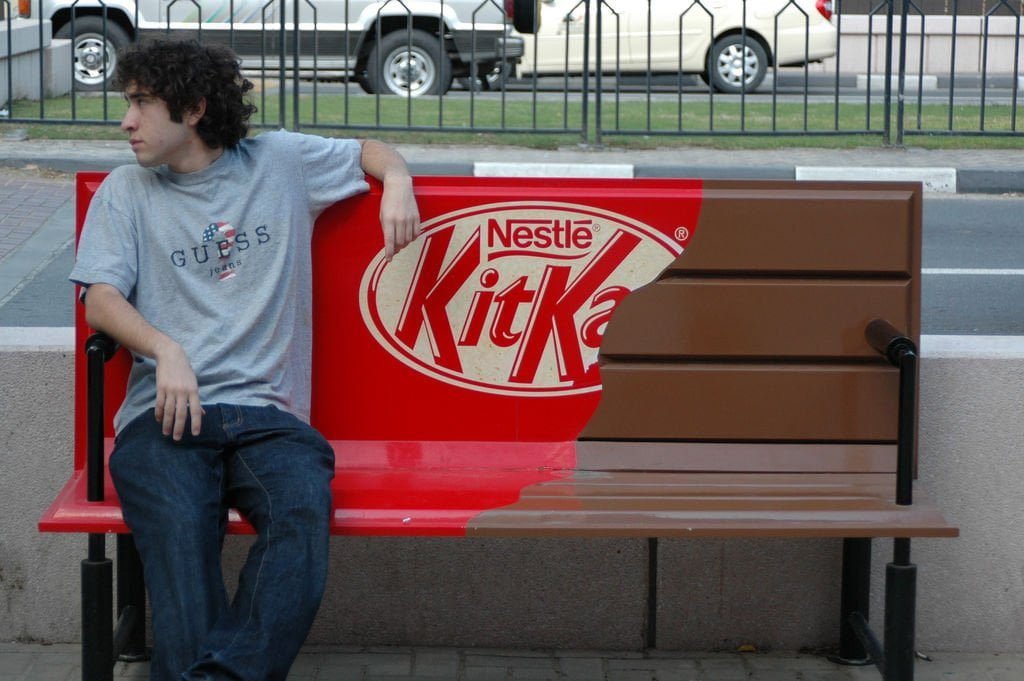चुपके विपणन क्या है? चुपके या चालबाज़ी विपणन दोनों का अर्थ एक ही होता है पर आधुनिक युग में दोनों का अलग-अलग जगाओं पर दोनों का अलग-अलग मतलब होते है। दोनों विपणन में बिना लोगों को यह अहसास कराए कि उत्पादों को वास्तव में उनके लिए विपणन किया जा रहा है स्पष्ट नहीं किया जाता है। विपणन उत्पादों का एक अप्रत्यक्ष तरीका है, चुपके विपणन दर्शकों के बीच चर्चा पैदा करने पर ध्यान केंद्रित करता है बिना लोगों को यह अहसास कराए कि उत्पादों को वास्तव में उनके लिए विपणन किया जा रहा है। Stealth Marketing किसी व्यक्ति के लिए कुछ ऐसा विज्ञापन कर रही है, जिसके बिना उन्हें यह अहसास कराया जाता है कि उनका विपणन किया जा रहा है। यह एक कम लागत वाली रणनीति है जो वास्तव में एक व्यवसाय के लिए मूल्यवान हो सकती है, लेकिन चुपके विपणन के साथ समस्या नैतिकता में से एक है। तो, हम किस प्रश्न पर चर्चा करने जा रहे हैं; चुपके विपणन का क्या मतलब है? व्याख्या के साथ…अंग्रेजी में पढ़ें!
यहाँ समझाया गया है; चुपके विपणन क्या है? मतलब के साथ उनके अवधारणा।
इस तथ्य के कारण कि उपभोक्ताओं की नई पीढ़ी पारंपरिक के प्रति कम आकर्षित हो रही है, आपके चेहरे के विज्ञापन में, विज्ञापन उद्योगों ने विज्ञापन के तहत “Under the Radar” दृष्टिकोण का निर्माण किया है। यह उपभोक्ताओं को यह विश्वास दिलाने के द्वारा किया जाता है कि वे विज्ञापन के बजाय प्रचार का जवाब दे रहे हैं। यह प्रचार विज्ञापन संचार के लिए अधिक सूक्ष्म दृष्टिकोण है, क्योंकि अधिकांश जनता उत्पादों के स्पष्ट विज्ञापन से जुड़ी नहीं होना चाहती है। इस तरह, उपभोक्ताओं को ऐसा महसूस नहीं होता है कि उन्हें कुछ बेचा जा रहा है, बल्कि उन्हें ऐसा लगता है कि वे कुछ खोज रहे हैं।
इस दृष्टिकोण को चुपके या गुप्त विपणन कहा जाता है, जो जागरूकता के बिना उपभोक्ता के जीवन में विपणन गतिविधियों को आसानी से नियुक्त करता है। ये अभियान पारंपरिक विज्ञापन से दूर रहते हैं, जहाँ उपभोक्ताओं को लगातार पता चलता है कि उन्हें कुछ बेचा जा रहा है। विज्ञापन का यह नया रूप उपभोक्ताओं के लिए संदेश संचारित करते समय “flying below the consumer’s radar” के लिए सबसे अच्छा काम कर रहा है। चूंकि विज्ञापन का यह नया रूप बहुत छिपा हुआ है और मीडिया और सार्वजनिक संचार के कई रूपों को लेने में सक्षम है, उपभोक्ता इस तथ्य के कारण गोपनीयता, विश्वास, पसंद की स्वतंत्रता और नियंत्रण खोने के लिए खड़े हैं कि वे इस तथ्य से अनजान हैं कि उन्हें राजी किया जा रहा है , उनकी सहमति की शक्ति को छीन लेना।
चुपके विपणन इसके चारों ओर एक “बज़” बनाकर नए उत्पादों और सेवाओं को प्रस्तुत करता है। कुछ व्यक्तियों को चुपचाप किसी उत्पाद या सेवा के बारे में बताने से यह विशिष्टता और “शांत” की भावना देता है। यह उपभोक्ताओं पर एक अनूठे तरीके से संदेश फैलाने वाले उपभोक्ताओं पर बहुत अधिक निर्भर करता है, यह सुनिश्चित करता है कि उत्पाद को विज्ञापन या कंपनी द्वारा प्रायोजित किए बिना प्रदर्शित किया जाए। इसकी सफलता यह है कि अगर उपभोक्ताओं का मानना है कि वे इस पर “लड़खड़ाए हुए” हैं या उन्होंने इसे खुद से पाया है, तो उन्हें पता है और विशेष महसूस होता है। पदोन्नति का यह रूप इस तथ्य के कारण प्रभावी है कि एक उपभोक्ता की खरीदारी साथियों की राय से बहुत प्रभावित होती है क्योंकि हम निर्णय लेते समय दूसरों की सलाह पर भरोसा करते हैं।
यह “चर्चा” इंटरनेट के रूप में ले सकता है क्योंकि यह पारंपरिक विज्ञापन की तुलना में सीधे उनके चेहरे पर नहीं होने के दौरान एक उपभोक्ता को संलग्न करने और मनाने के लिए सबसे कुशल और लागत प्रभावी तरीका है। सोशल नेटवर्किंग, वायरल Marketing और guerrilla अभियान इसके उदाहरण हैं, इस तथ्य के कारण कि वे सभी इस तथ्य को भुनाने में लगे हैं कि इंटरनेट एक साथ कई लोगों को एक साथ जोड़ सकता है, जिसमें मूल्यों, व्यवहारों और विश्वासों को प्रभावित करने की क्षमता होती है। उपभोक्ताओं की। ब्रांड पुशर्स, जिन्हें काम पर रखा गया है, वास्तविक जीवन में लोगों से संपर्क करते हैं और वास्तव में यह कहे बिना उत्पादों का प्रचार करते हैं कि वे किसी उत्पाद या सेवा का प्रचार कर रहे हैं।
वे व्यक्तिगत रूप से बार या संगीत स्टोर और पर्यटक आकर्षण में बातचीत में ब्रांडों या उत्पादों को बाहर निकालते हैं। ये कलाकार वास्तविक होने के लिए वास्तविक और स्वीकार्य होने के रूप में सामने आते हैं। उपभोक्ता की नाक के नीचे उत्पाद लगाकर यह कुछ रुझानों से सैकड़ों तक प्रभाव की श्रृंखला बनाता है।
इसका एक उदाहरण जिसने विवाद पैदा किया 2002 में Stony Ericsson’s Stealth अभियान था। यह तब था जब संयुक्त राज्य अमेरिका के दस पर्यटक शहरों में पोज देने के लिए 60 अभिनेताओं को काम पर रखा गया था। ये अभिनेता असंपादित लोगों से एम्पायर बिल्डिंग बिल्डिंग जैसे पर्यटक आकर्षण के पास नए लॉन्च किए गए T68i कैमरा फोन के साथ उनकी तस्वीरें लेने के लिए कहेंगे। एक बार जब कोई व्यक्ति सहमत हो जाता है तो स्क्रिप्टेड अभिनेता यह प्रदर्शित करेगा कि फोन का उपयोग कैसे करना है और इसके लाभों और विशेषताओं के बारे में चर्चा करेंगे। वे यह सब करते हुए कभी भी दूसरे व्यक्ति को यह बताने नहीं देंगे कि वे सोनी एरिक्सन के प्रतिनिधि थे।
इस उदाहरण के माध्यम से, यह पहली बार दिखाया जा सकता है कि चुपके विज्ञापन के इस रूप में उपभोक्ताओं को धोखा देने की क्षमता है। ये अनजान उपभोक्ता इस बात से अनजान थे कि उन्हें एक उत्पाद बेचा जा रहा है क्योंकि विपणन और वाणिज्यिक प्रायोजक उनके सामने नहीं आए थे। दूसरे, यह घुसपैठ के एक रूप को दर्शाता है, क्योंकि यह उपभोक्ता की गोपनीयता के उल्लंघन को दर्शाता है। अन्य पर्यटकों और राहगीरों को उनके दिन और दर्शनीय स्थलों की यात्रा में बाधित किया गया, ताकि एक और “पर्यटक” की सहायता की जा सके, जिससे अभिनेताओं को कैमरे के उत्पादन का प्रदर्शन करने का अवसर मिल सके। तीसरा, यह उपभोक्ताओं का शोषण करता है; जैसा कि यह दर्शाता है कि मनुष्यों का लाभ उठाने के लिए कैसे चुपके विपणन निभाता है।
सोनी एरिक्सन के इस मामले से पता चलता है कि उन्होंने किसी उत्पाद की Marketing में दूसरों की दया का इस्तेमाल किया। गोपनीयता और निगरानी तब चलती है जब खुदरा विक्रेता डेटा-संग्रह प्रणाली के उपयोग के माध्यम से चुपके विपणन का उपयोग करते हैं। यह एक रिटेलर के माध्यम से किया जाता है, जहां प्रत्येक ग्राहक को उनके क्रेडिट या डेबिट कार्ड के साथ एक कोड नंबर सौंपा जाता है। यह कोड उनके व्यक्तिगत खरीद इतिहास को वहन करता है जिसे तब अन्य वस्तुओं को खरीदते समय विश्लेषण और ट्रैक करने के लिए संग्रहीत किया जाता है।
विशिष्ट प्रचार तब उन उपभोक्ताओं को दिया जाता है जो उत्पादों के प्रोफाइल के अनुरूप होते हैं। इस प्रणाली से नज़र रखने से बचने का एकमात्र तरीका यह है कि ग्राहक नकद भुगतान करे और अपना फ़ोन नंबर न दे। न केवल उनकी खरीदारी को ट्रैक किया जा सकता है, बल्कि सोशल नेटवर्किंग साइटों पर उनके वेब ब्राउज़िंग, क्रेडिट इतिहास और वार्तालापों को भी बिना किसी ज्ञान के ट्रैक किया जा सकता है, जिस पर उनकी व्यक्तिगत जानकारी देखी जा रही है।
इस डेटा संग्रह प्रणाली में से अधिकांश एक ऑप्ट-आउट प्रोग्राम पर आधारित है, जिसे समझना और ले जाना बहुत मुश्किल है, इस तथ्य के कारण कि सभी गोपनीयता नीतियों को समझने में इतना समय लगता है, जो वास्तव में अभ्यास नहीं हो सकता है। ये संग्रह विपणक इस पर भरोसा करते हैं ताकि एक उपभोक्ता यह नियंत्रित करने का प्रयास करे कि वे जो ट्रैकिंग कर रहे हैं उसे रोक दिया गया है क्योंकि यह करना कितना मुश्किल है जब आप का व्यक्तिगत डेटा पहले से ही सिस्टम में है।
केवल एक चौथाई उपभोक्ताओं का मानना है कि ऑप्ट-आउट करने से यह केवल अनुरूप विज्ञापनों को रोकता है, जहां बाकी लोगों का मानना है कि बाहर निकलने का अर्थ है कि यह सभी प्रकार के ऑनलाइन ट्रैकिंग को रोक देगा। कई साइट उपभोक्ता ब्राउज़ करते हैं जिनमें ट्रैकिंग टूल और कुकीज़ होती हैं जो ऑनलाइन किए गए किसी भी मूवमेंट को रिकॉर्ड करते हैं। इसकी तुलना वीडियो कैमरा और माइक्रोफोन से की जा सकती है, जो किसी व्यक्ति के घर में बिना सहमति या उसके होने के ज्ञान के साथ रखा जा रहा है।
ट्रैकिंग सॉफ़्टवेयर के उपयोग के माध्यम से अन्य व्यक्ति जो कुछ भी देख सकते हैं उसे नियंत्रित करने में यह अक्षमता, न केवल गोपनीयता का उल्लंघन है, बल्कि उपभोक्ता के विश्वास का भी उल्लंघन है। भले ही विज्ञापन और विपणन का यह नया रूप अभिनव है और उत्पादों और सेवाओं को बहुत भीड़ भरे बाजार में बाहर खड़ा करने के लिए मिलता है, कला और विज्ञापन की रेखा आज के समाज में धुंधली होती दिख रही है। यह गाने, टीवी, फिल्म और वीडियो गेम में उत्पाद प्लेसमेंट के साथ देखा जा सकता है।
यह नैतिकता के मुद्दों को लाता है, जहां उपभोक्ता के दिमाग में हेरफेर करने के प्रयास के लिए चुपके विपणन को देखा जा सकता है, जहां इसकी तुलना अचेतन विज्ञापन से की जा सकती है, क्योंकि इसका उद्देश्य उपभोक्ता के अवचेतन स्तर के बारे में जागरूकता है। पारंपरिक विपणन के साथ, ऐसे उपभोक्ता थे जो उन संदेशों का चयन करने में सक्षम थे जिन्हें वे उन विज्ञापनों को अनदेखा करना चाहते थे जिनकी वे रुचि नहीं रखते थे, उपभोक्ताओं को अपने विचारों और निर्णयों पर नियंत्रण देते थे, न कि बाज़ारियों को।
Stealth Marketing के समर्थकों का कहना है कि विज्ञापन का यह रूप इस तथ्य के कारण पारंपरिक विज्ञापन से अधिक विश्वसनीय है कि कुछ उपभोक्ता एथलीटों और मशहूर हस्तियों का मानना है कि जो उत्पाद और सेवाएं वास्तव में उनका उपयोग करते हैं। साथ ही Stealth Marketing के पैरोकारों का कहना है कि चूंकि आज उपभोक्ता मीडिया और तकनीक के जानकार हैं, इसलिए “Tune out commercials disguised as entertainment”।

हालांकि, पारंपरिक विपणन में, उपभोक्ता और विज्ञापन के बीच आदान-प्रदान होता है। उपभोक्ता को उत्पाद का ज्ञान होता है, विज्ञापन में उपयोग किए जाने वाले प्रेरक साधनों को समझता है, और उत्पाद या सेवा के विपणन प्रायोजक का ज्ञान होता है। लेकिन, Stealth Marketing प्रायोजक और अनुनय के ज्ञान को कम कर देता है, जिससे यह उपभोक्ता से छिप जाता है। इसमें किसी भी रक्षा तंत्र के उपभोक्ता को वंचित करने की क्षमता है, जो विज्ञापन या विपणन संचार के साथ सामना करने के दौरान एक जागरूक और सूचित निर्णय लेने में मदद करता है।
दुर्भाग्य से, विपणन का यह रूप प्रभावी है, क्योंकि यह किसी उत्पाद या सेवा की पूरी जानकारी का खुलासा करने में विफल रहता है। यह उपभोक्ताओं की प्रवृत्ति को संदेह या विश्वास से दूर ले जाता है कि किसी विज्ञापन का एक उल्टा मकसद है। इसके माध्यम से, उपभोक्ता की पसंद और निर्णय की स्वतंत्रता को उसके साथ दूर ले जाया जाता है। इस तथ्य के कारण कि आज की उपभोक्ता दुनिया में चुपके विपणन इतना प्रभावी हो गया है, इसमें संचार की एक विस्तृत श्रृंखला के माध्यम से उपभोक्ताओं के व्यापक जनसांख्यिकीय के विकल्पों को खतरे में डालने की क्षमता है।
जैसा कि कई उपभोक्ता अब अपने बचाव तंत्र को मनाने की क्षमता को नियंत्रित करने और दुरुपयोग करने की अपनी क्षमता का एहसास कर रहे हैं, चुपके विपणन जनता के भीतर अविश्वास और संदेह पैदा कर सकता है, जो अपरिवर्तनीय हो सकता है। यह न केवल “रडार के तहत” विज्ञापन के लिए गंभीर प्रभाव का कारण बनता है, बल्कि पहले से ही खतरे के पारंपरिक रूपों में, सवाल पूछ रहा है: अगर इसके लिए कोई बाजार नहीं है तो विज्ञापन का भविष्य क्या है?




